1. Introduction
Nowadays many microservice applications are deployed in the form of containers in a Kubernetes Cluster. There are multiple ways to configure these containers. The configuration can be …
-
shipped within the image itself
-
passed on a mounted volume
-
passed as environment variables
-
sourced from a configmap
-
sourced from a secret
-
-
retrieved from an external service
If you are using ConfigSeeder to manage your configuration data, you can either fetch the required configuration data with an init-container (Scenario 2, OS Connector or SimpleConfigDownloader) or retrieve it directly with a ConfigSeeder Client (Scenario 4). In either case, an API Key is required to retrieve configuration data from ConfigSeeder.
These API Keys can be managed (created and replaced before expiration) manually or automatically by Kubernetes Connector.
The Kubernetes Connector reads Assemblies of type Secret: API Key from ConfigSeeder and manages API Keys within
Kubernetes Secrets.
At the moment, the Kubernetes Connector is limited to manage API Keys. Soon (planned for the end of September) the Kubernetes Connector will have the ability to provision configuration data stored in ConfigMaps and Secrets (Scenario 3a/b).
1.1. Use cases
The kubernetes-connector can be used for the following scenarios:
-
Provide API Keys with access to configured
Configuration Groupswithin Secrets. -
Provide ConfigMaps containing key/value pairs
-
Provide Secrets of type
opaquecontaining key/value pairs
2. Quickstart
2.1. Introduction
2.1.1. Content of the quickstart manual
The kubernetes-connector can to provide API Keys for accessing configuration data to a kubernetes cluster. This quickstart guide gives an introduction to the use of the kubernetes-connector.
You will understand, how
-
Secrets containing an API Key are defined in ConfigSeeder
-
multiple environments/namespaces are supported
-
labels and annotations can be set
This quickstart guide also offers links to more detailed information.
|
Please be advised that the kubernetes-connector is under heavy development and currently available as a tech preview. The structure of the configValues used to configure kubernetes objects can be changed in the future. Expect that other things like the described behavior will also be changed. |
2.1.2. Preconditions
-
ConfigSeeder up and running
-
Licence which supports the use of the kubernetes-connector
-
Connectivity from the machine or cluster running kubernetes-connector to the ConfigSeeder
-
Access to a kubernetes cluster and permission to manage kubernetes objects like namespaces, service accounts, secrets and rbac roles & bindings.
2.2. Prepare ConfigSeeder Management
-
Create the Environments
TESTandPROD -
Create the Configuration Group
kubernetes-connector-job-demo -
Create the Configuration Group
demo-application
2.3. Setup Kubernetes Connector
The following actions are required to set up Kubernetes Connector:
-
Create Namespace in which the Connector should be running.
ns.yamlapiVersion: v1 kind: Namespace metadata: name: cs-demo-k8s-connectorkubectl apply -f ns.yaml -
Create the Serviceaccount with which the Connector will connect to the Kubernetes Master.
sa.yamlapiVersion: v1 kind: ServiceAccount metadata: name: cs-demo-k8s-connector namespace: cs-demo-k8s-connectorkubectl apply -f sa.yaml -
Give the ServiceAccount permission to store state-information (in this quickstart guide it is expected that the state will be stored in the same Namespace in which the Kubernetes Connector(s) are running). Also, prepare a ClusterRole with access to the Kubernetes Object Types which will be managed by Kubernetes Connector.
rbac.yamlkind: Role apiVersion: rbac.authorization.k8s.io/v1 metadata: name: cs-demo-k8s-connector-state namespace: cs-demo-k8s-connector rules: - apiGroups: [""] resources: ["configmaps"] verbs: ["create", "get", "update", "delete"] --- kind: RoleBinding apiVersion: rbac.authorization.k8s.io/v1 metadata: name: cs-demo-k8s-connector-state namespace: cs-demo-k8s-connector subjects: - kind: ServiceAccount name: cs-demo-k8s-connector namespace: cs-demo-k8s-connector roleRef: kind: Role name: cs-demo-k8s-connector-state apiGroup: rbac.authorization.k8s.io --- kind: ClusterRole apiVersion: rbac.authorization.k8s.io/v1 metadata: name: cs-demo-k8s-connector rules: - apiGroups: [""] resources: ["configmaps", "secrets"] verbs: ["create", "get", "update", "delete"]kubectl apply -f rbac.yaml -
Create the Namespaces in which the Kubernetes Connector shall manage Kubernetes objects and give the ServiceAccount permission to manage the objects. In this quickstart guide, the namespaces
cs-demo-application-testandcs-demo-application-prodare used.ns-example.yamlapiVersion: v1 kind: Namespace metadata: name: cs-demo-application-test --- apiVersion: v1 kind: Namespace metadata: name: cs-demo-application-prod --- apiVersion: v1 kind: Namespace metadata: name: cs-demo-ansible-prod --- kind: RoleBinding apiVersion: rbac.authorization.k8s.io/v1 metadata: name: cs-demo-k8s-connector namespace: cs-demo-application-test subjects: - kind: ServiceAccount name: cs-demo-k8s-connector namespace: cs-demo-k8s-connector roleRef: kind: ClusterRole name: cs-demo-k8s-connector apiGroup: rbac.authorization.k8s.io --- kind: RoleBinding apiVersion: rbac.authorization.k8s.io/v1 metadata: name: cs-demo-k8s-connector namespace: cs-demo-application-prod subjects: - kind: ServiceAccount name: cs-demo-k8s-connector namespace: cs-demo-k8s-connector roleRef: kind: ClusterRole name: cs-demo-k8s-connector apiGroup: rbac.authorization.k8s.io --- kind: RoleBinding apiVersion: rbac.authorization.k8s.io/v1 metadata: name: cs-demo-k8s-connector namespace: cs-demo-ansible-prod subjects: - kind: ServiceAccount name: cs-demo-k8s-connector namespace: cs-demo-k8s-connector roleRef: kind: ClusterRole name: cs-demo-k8s-connector apiGroup: rbac.authorization.k8s.iokubectl apply -f ns-example.yaml -
Create Image Pull Secrets in all Namespaces to access Docker Images from Docker Hub (https://cloud.docker.com/u/configseeder/):
kubectl create secret docker-registry -n cs-demo-k8s-connector image-pull-secret \ --docker-username=<username> \ --docker-password=<password>kubectl create secret docker-registry -n cs-demo-application-test image-pull-secret \ --docker-username=<username> \ --docker-password=<password>kubectl create secret docker-registry -n cs-demo-application-prod image-pull-secret \ --docker-username=<username> \ --docker-password=<password> -
Create API Key used by the Kubernetes Connector to access ConfigSeeder:
-
Create API Key of Type
Kubernetes Connectorwith access to the relevant Configuration Groups and Environments: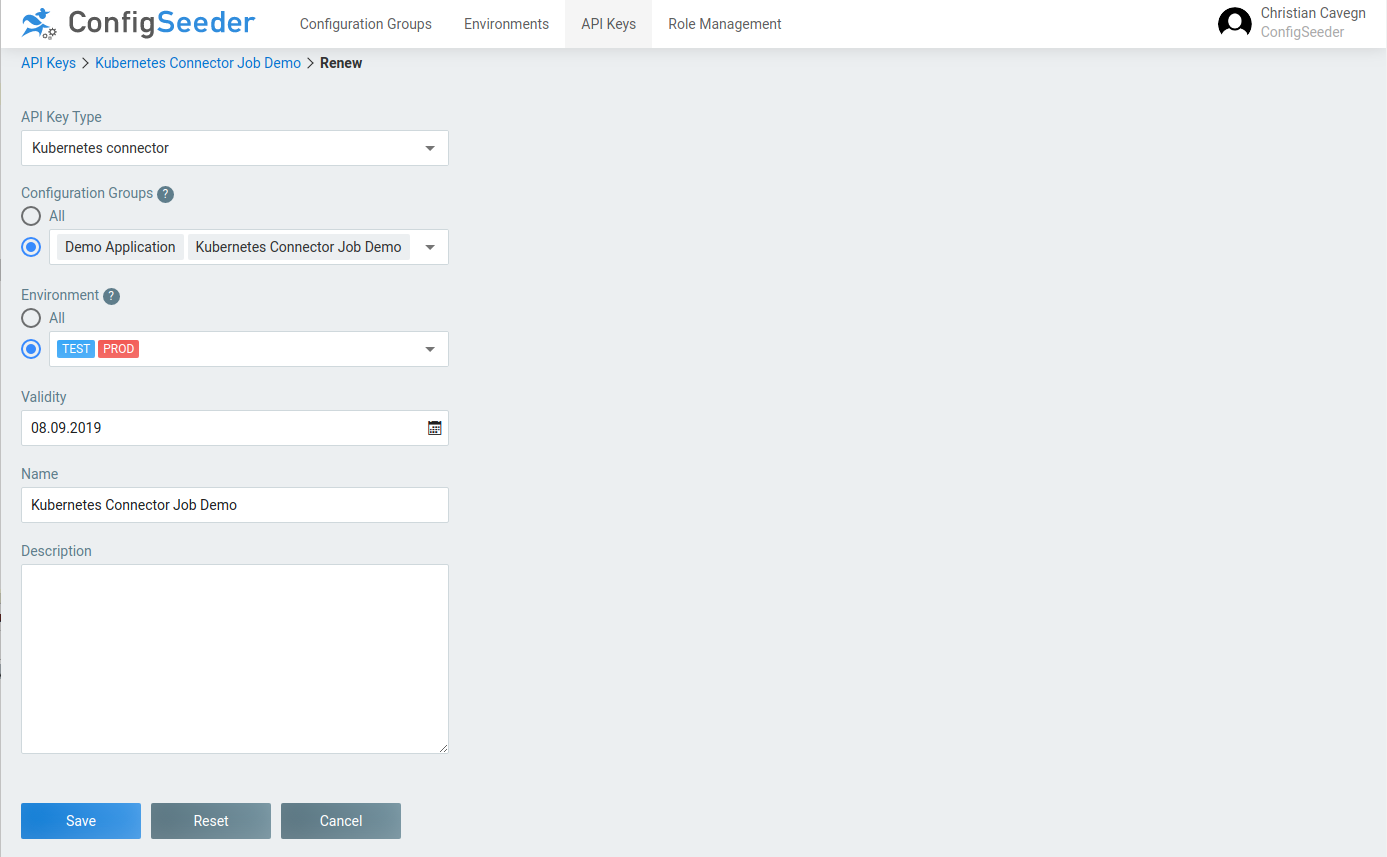
-
Store generated API Key in file
apikey.txt -
Create Secret:
kubectl create secret generic -n cs-demo-k8s-connector cs-demo-k8s-connector-apikey \ --from-file=apikey=apikey.txt
-
-
Store configuration used by Kubernetes Connector in a ConfigMap:
cs-demo-k8s-connector-config.yamlapiVersion: v1 kind: ConfigMap metadata: name: cs-demo-k8s-connector-config namespace: cs-demo-k8s-connector data: CONNECTOR_APIKEY_LIFETIMEINDAYS: "2" CONNECTOR_APIKEY_RECREATEDAYSBEFOREEXPIRATION: "1" CONNECTOR_CONFIGSEEDER_SERVERURL: https://staging-postgres-config-seeder.oneo.cloud CONNECTOR_CONFIGSEEDER_TENANTKEY: configseeder CONNECTOR_CONFIGSEEDER_CONFIGURATIONGROUPKEYS: kubernetes-connector-job-demo CONNECTOR_CONFIGSEEDER_CONNECTIONTIMEOUT: "5000" CONNECTOR_CONFIGSEEDER_READTIMEOUT: "5000" CONNECTOR_LOG_LEVEL: "INFO" CONNECTOR_STARTUPRETRYWAITTIME: "10000" CONNECTOR_STATEMANAGER_NAMESPACE: "cs-demo-k8s-connector"Be sure to set the follwing options to the correct values:
CONNECTOR_CONFIGSEEDER_SERVERURL CONNECTOR_CONFIGSEEDER_TENANTKEY CONNECTOR_CONFIGSEEDER_CONFIGURATIONGROUPKEYSkubectl apply -f cs-demo-k8s-connector-config.yaml
2.4. Execute the Kubernetes Connector
|
If the Kubernetes Connector is started as a |
2.4.1. Periodically execute Kubernetes Connector with a CronJob
Starting Kubernetes Connector with a CronJob is usually done if exact timing of a configuration Change is not really relevant and configuration changes should be applied to kubernetes as soon as possible (e.g. for dev or test environments).
-
Create CronJob Template
cs-demo-k8s-connector-cronjob-test.yamlapiVersion: batch/v1beta1 kind: CronJob metadata: name: cs-demo-k8s-connector-cronjob-test namespace: cs-demo-k8s-connector spec: schedule: "*/5 * * * *" # Don't execute Job more than once at the same time concurrencyPolicy: Forbid failedJobsHistoryLimit: 5 successfulJobsHistoryLimit: 1 jobTemplate: spec: # Don't do any retries backoffLimit: 0 template: spec: # Don't restart if an error occures restartPolicy: Never containers: - name: kubernetes-connector image: configseeder/kubernetes-connector:1.0.0-alpine #image: registry.gitlab.com/configseeder/kubernetes-connector/kubernetes-connector:staging-alpine imagePullPolicy: Always envFrom: - configMapRef: name: cs-demo-k8s-connector-config env: - name: CONNECTOR_CONFIGSEEDER_ENVIRONMENTKEY value: "TEST" - name: CONNECTOR_STATEMANAGER_NAME value: "cs-demo-k8s-connector-state-test" - name: CONNECTOR_CONFIGSEEDER_APIKEY valueFrom: secretKeyRef: name: cs-demo-k8s-connector-apikey key: apikey #imagePullSecrets: # - name: image-pull-secret serviceAccountName: cs-demo-k8s-connector -
Start CronJob
startCronJobTest.sh#!/bin/bash kubectl apply -f cs-demo-k8s-connector-cronjob-test.yaml./startCronJobTest.sh -
Stop / Delete CronJob
stopCronJobTest.sh#!/bin/bash kubectl delete -f cs-demo-k8s-connector-cronjob-test.yaml./startCronJobTest.sh
2.4.1.1. Results
As long as no Value Assembly of Type Secret: API Key is created in Configuration Group kubernetes-connector-job-demo
the Kubernetes Connector won’t do anything.
-
No secret should have been created:
kubectl get secret -n cs-demo-application-test -
No error should be logged:
kubectl logs -n cs-demo-k8s-connector cs-demo-k8s-connector-cronjob-test-<…> -
No Object should be managed by Kubernetes Connector:
kubectl get cm -n cs-demo-k8s-connector cs-demo-k8s-connector-state-test -o yaml
If a Value Assembly of Type Secret: API Key has been created or changed, re-executing the shell script is not required.
The CronJob will re-execute Kubernetes Connector after the defined time and the changes will be applied automatically.
2.4.2. Start Kubernetes Connector as a Job
Starting Kubernetes Connector with a CronJob is usually done if exact timing of a configuration Change is relevant (e.g. for production level or similar environments).
-
Create Job Template
cs-demo-k8s-connector-job-prod.yamlapiVersion: batch/v1 kind: Job metadata: name: cs-demo-k8s-connector-job namespace: cs-demo-k8s-connector spec: # Don't do any retries backoffLimit: 0 # Automatically clean up after 7 days ttlSecondsAfterFinished: 604800 template: spec: # Don't restart if an error occures restartPolicy: Never containers: - name: kubernetes-connector image: configseeder/kubernetes-connector:1.0.0-alpine #image: registry.gitlab.com/configseeder/kubernetes-connector/kubernetes-connector:staging-alpine imagePullPolicy: Always envFrom: - configMapRef: name: cs-demo-k8s-connector-config env: - name: CONNECTOR_CONFIGSEEDER_ENVIRONMENTKEY value: "PROD" - name: CONNECTOR_STATEMANAGER_NAME value: "k8s-connector-state-prod" - name: CONNECTOR_CONFIGSEEDER_APIKEY valueFrom: secretKeyRef: name: cs-demo-k8s-connector-apikey key: apikey #imagePullSecrets: # - name: image-pull-secret serviceAccountName: cs-demo-k8s-connector -
Execute Job
startJobProd.sh#!/bin/bash timestamp=`date +%F-%H.%M.%S` jobYaml=`sed -e "s/k8s-connector-job/k8s-connector-job-${timestamp}/g" cs-demo-k8s-connector-job-prod.yaml` echo "$jobYaml" | kubectl apply -f -./startJobProd.sh
2.4.2.1. Results
As long as no Value Assembly of Type Secret: API Key is created in Configuration Group kubernetes-connector-job-demo
the Kubernetes Connector won’t do anything.
-
No secret should have been created:
kubectl get secret -n cs-demo-application-prod -
No error should be logged:
kubectl logs -n cs-demo-k8s-connector cs-demo-k8s-connector-job-<…> -
No Object should be managed by Kubernetes Connector:
kubectl get cm -n cs-demo-k8s-connector cs-demo-k8s-connector-state-prod -o yaml
If startJobProd.sh is (re)executed after a Value Assembly of Type Secret: API Key has been created, the given
commands should show details of the created secret.
2.5. Manage a Secret containing an API Key
Create a ValueAssembly of Type Secret: API Key in Configuration Group Kubernetes Job Demo:
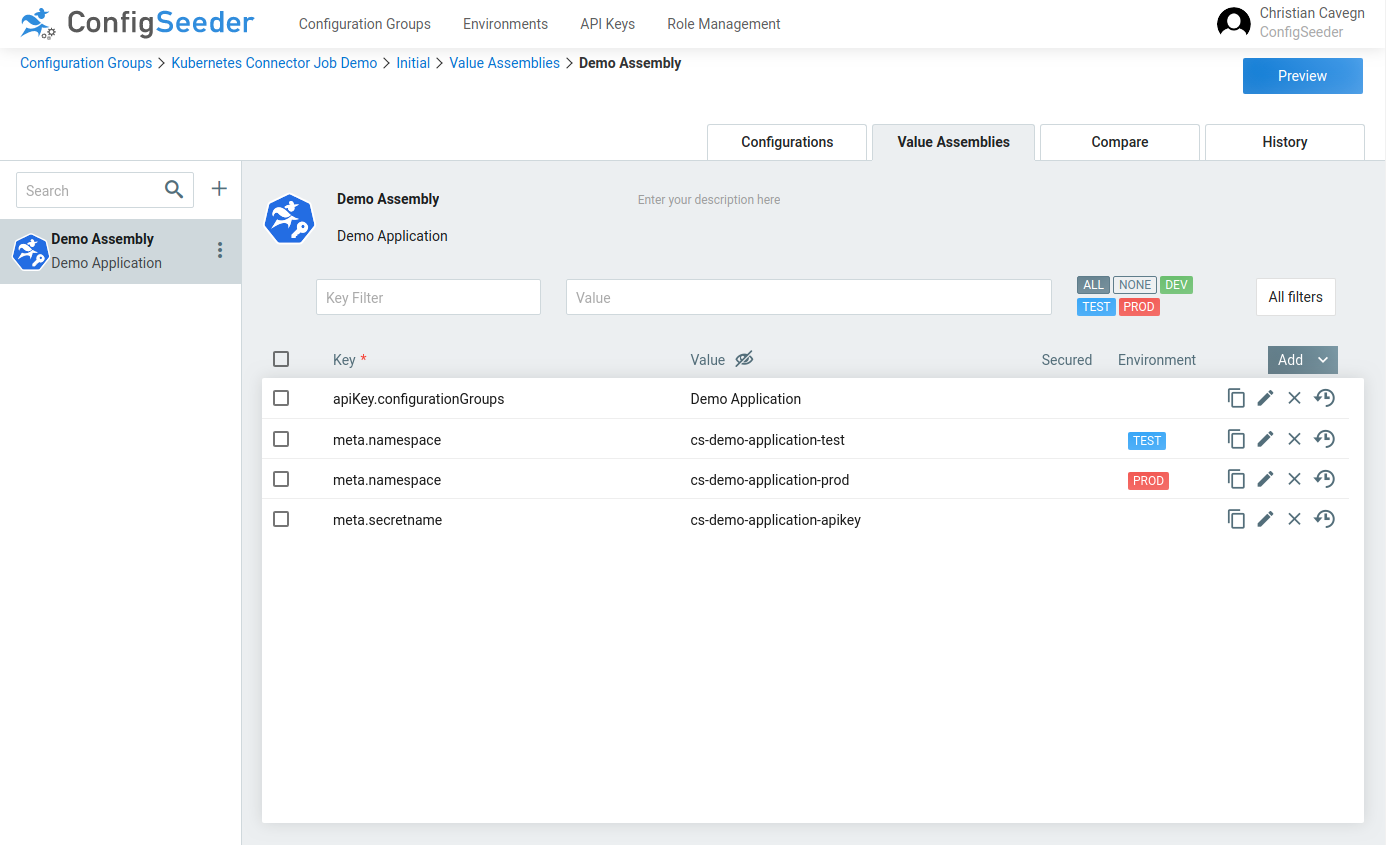
Reexecute Job or wait until CronJob has run again, check results.
2.6. Set a label or annotation
Modify previously created ValueAssembly:
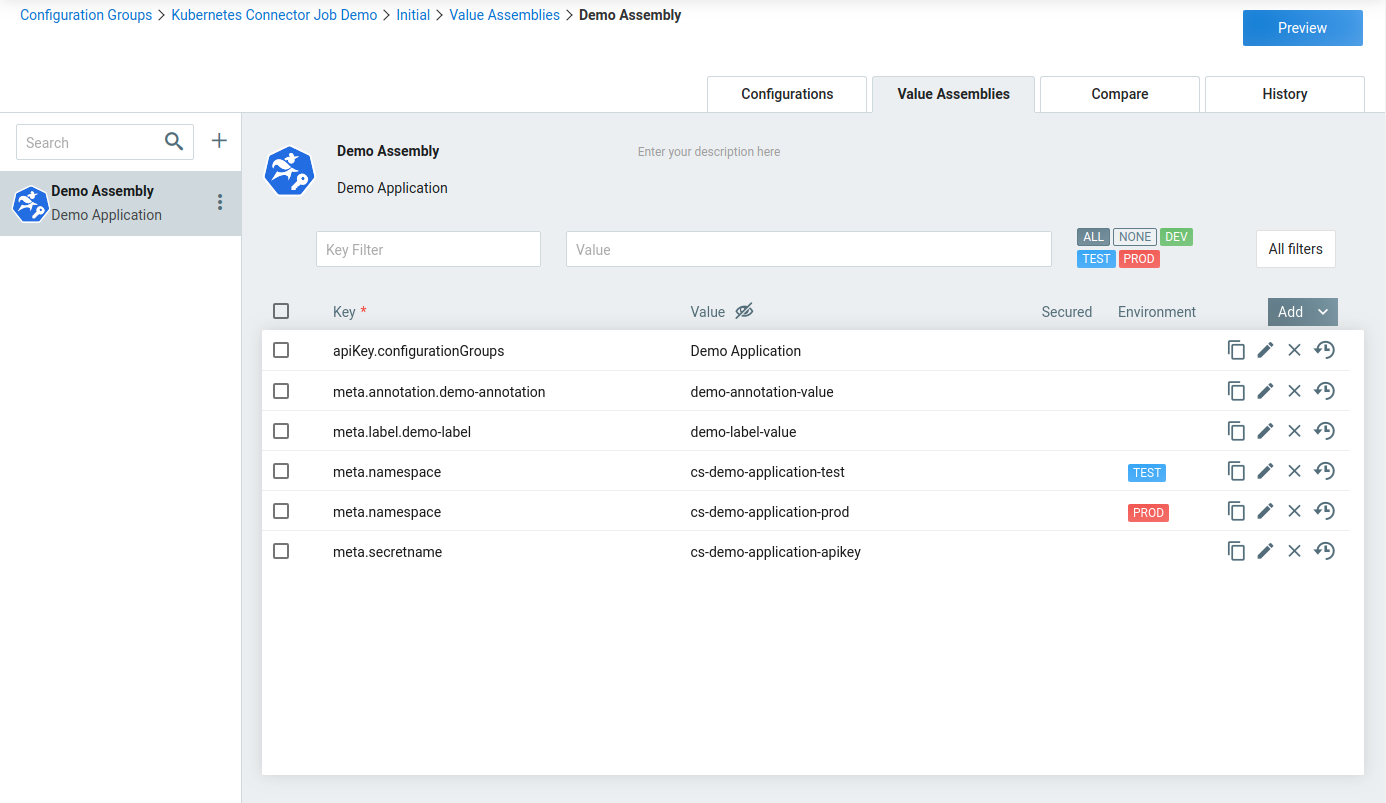
Reexecute Job or wait until CronJob has run again, check results.
3. Kubernetes Connector Configuration
3.1. Ways to configure the Connector
This section describes every available configuration option available for Kubernetes Connector and it’s modules.
There are three ways to configure the connector:
-
Configuration by file (lowest priority)
Default filename is
connector.yaml, the connector looks for the file in the directoy it is started from. The filename can be overwritten, see Configuration Options.Example:
connector: log: level: DEBUG apiKey: lifetimeInDays: 2 recreateDaysBeforeExpiration: 1 configSeeder: tenantKey: "configseeder" environmentKey: "TEST" configurationGroupKeys: "kubernetes-connector-integrationtest" serverUrl: "https://staging-postgres-config-seeder.oneo.cloud" -
Configuration by environment variables
Example:
export CONNECTOR_LOG_LEVEL=DEBUG export CONNECTOR_CONFIGSEEDER_APIKEY=xxxx ... kubernetes-connector -
Configuration by startup parameter (highest priority)
Example:
kubernetes-connector -connector.log.level=DEBUG -connector.configseeder.apikey=xxx ...
It is possible to mix the different ways to configure the connector. You probably want to configure the connector by
file and provide the API Key with an environment variable so it isn’t readable by anyone (You don’t want to provide the
API Key as a startup parameter because the values of startup parameters can be retrieved by anyone using ps awx).
|
Priorities of ways to configure the connector
|
3.2. Configuration Options
The Kubernetes Connector can be configured by the following options:
|
All keys are prefixed with |
| Key | Mandatory | Value |
|---|---|---|
|
no |
Location and name of the configfile containing the connector configuration. Defaults to |
|
no |
Can be set to |
|
yes |
Defines how many days an API Key created by Kubernetes Connector will be valid. |
|
yes |
Defines how many days before reaching the expiration date an API Key managed by Kubernetes Connector should be replaced. The replaced API Key won’t be invalidated. This configuration option must be smaller than |
|
yes |
Must be set to Defaults to |
|
yes |
API Key used by Connector to access ConfigSeeder. The API Key must be of Type |
|
yes |
Defines which configuration groups should be read by the Connector. |
|
no |
Optional for filtering configuration values by |
|
no |
Connection Timeout, defaults to |
|
no |
Optional for filtering configuration values by Defaults to now. |
|
yes |
Environment for which the Connector is running. |
|
no |
Defines, how many times the connector should try to connect to ConfigSeeder Defaults to |
|
no |
Read Timeout, defaults to |
|
no |
Time in Milliseconds between failed tries to connect to ConfigSeeder. Defaults to |
|
yes |
URL under which ConfigSeeder can be reached. |
|
no |
Defaults to Tenant |
|
no |
Optional for filtering configuration values by |
|
no |
Name (and path) of the kubernetes config file used by Kubernetes Connector to connecto to the cluster. Only used if the Kubernetes Connector runs outside of a Kubernetes Cluster. |
|
no |
Name of the Logfile if logging to a file is configured. Defaults to |
|
no |
ogLevel for the connector, valid levels are: trace, debug, info, warning, error, fatal, panic. Defaults to 'info' |
|
no |
Target for the connector logging, valid targets are CONSOLE, CONSOLE_AND_FILE and FILE. Defaults to 'CONSOLE'. |
|
yes |
Must be set to |
|
no |
Maximum duration in milliseconds which is waited if there is a problem
connecting to the ConfigSeeder at startup time. Not setting Defaults to endless retries (not default set). |
|
no |
Duration in milliseconds which is waited between retries if there is a problem connecting to the ConfigSeeder at startup time. Defaults to |
|
no |
Name of the ConfigMap containing the state Defaults to If more than one Kubernetes Connector is used, it must be ensured that every Connector has its own combination of
|
|
no |
Namespace in which the ConfigMap containing the state is created. Defaults to If more than one Kubernetes Connector is used, it must be ensured that every Connector has its own combination of
|
|
The specified keys can be easily translated to environment variable names:
|
4. Modules
4.1. Introduction
Different modules are responsible for managing different kind of configuration data. The following table gives an overview of the available modules.
| Module | Assembly | Description |
|---|---|---|
AKM (Api Key Management) |
Secret: API Key |
Create and manage secrets which contain API Keys which grant access to ConfigSeeder. |
CMM (ConfigMap Management Module) |
ConfigMap: Key/Value (Local) |
Create and manage ConfigMaps where the configuration data is stored directly in the Assembly. |
ConfigMap: Key/Value (Referenced) |
Create and manage ConfigMaps where the configuration data is stored in referenced configuration groups. |
|
SMM (Secret Management Module) |
Secret: Key/Value (Local) |
Create and manage Secrets where the configuration data is stored directly in the Assembly. |
Secret: Key/Value (Referenced) |
Create and manage Secrets where the configuration data is stored in referenced configuration groups. |
All modules can by configured with different options. The following table shows the configuration options which are valid for all the modules:
| Key | Mandatory | Value |
|---|---|---|
|
yes |
With this flag, an assembly can be activated or deactivated for different scenarios. To enable an assembly for just environment
To disable an assembly for context
|
|
no |
Used to set one or more annotations (replace xxx with name of annotation) |
|
no |
Used to set one or more label (replace xxx with name of label) |
|
yes |
Namespace in which the kubernetes object will be created. If more than one Environment is used, there could be
|
4.2. Api Key Management (Module AKM)
4.2.1. Introduction
The AKM Module is responsible for creating API Keys that are stored in Kubernetes Secrets.
The required API Keys/secrets are configured with Value Assemblies of type Secret: API Key within ConfigSeeder:
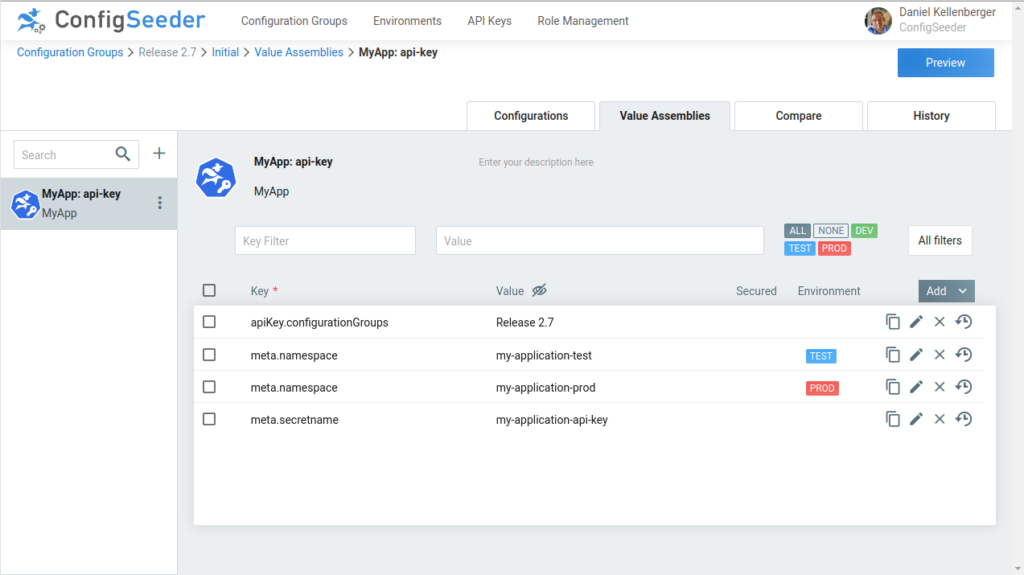
The example above would create a secret named my-application-api-key
-
in the namespace
my-application-testcontaining an API Key which grants access on environmentTESTand configuration groupRelease 2.7 -
in the namespace
my-application-prodcontaining an API Key which grants access on environmentPRODand configuration groupRelease 2.7
The created kubernetes object should look like this:
kubectl get secret -n my-application-test my-application-api-key -o yaml
apiVersion: v1
data:
apiKey: ZXlKc.....tYSQ==
kind: Secret
metadata:
annotations:
configseeder.com/managed: "true"
configseeder.com/module: AKM
name: name: secret-apikey-1
namespace: my-application-test
type: Opaque4.2.2. Usage of Configuration Values within Value Assembly
| Key | Mandatory | Value |
|---|---|---|
|
yes |
This value specifies to which configurationGroups the created API Key will have access. |
|
yes |
Name of the Secret which will be created because of this Value Assembly. If more than one Environment is used, there could be
However, we recommend having a dedicated namespace for each application and environment. |
4.3. ConfigMap: Key/Value Local (Module CMM)
4.3.1. Introduction
This module is responsible for creating and managing ConfigMaps containing key / value pairs.
The key / value pairs are configured directly in a Value Assemblies of type ConfigMap: Key/Value (Local) within ConfigSeeder:

The example above would create a ConfigMap named my-application-cm-local
-
in the namespace
my-application-testcontaining the keya_keywith valuea_value_test -
in the namespace
my-application-prodcontaining the keya_keywith valuea_value_prod
|
When managing a ConfigMap with ConfigSeeder
|
The created kubernetes object should look like this:
kubectl get cm -n my-application-test my-application-cm-local -o yaml
apiVersion: v1
data:
a_key: a_value_test
kind: ConfigMap
metadata:
annotations:
configseeder.com/dataHash: f9724b05cdbf38c3ba95325edfe26f166b3d73046e9804af6d672e74d9c9a1f4
configseeder.com/managed: "true"
configseeder.com/module: CMM_KVL
name: my-application-cm-local
namespace: my-application-test4.3.2. Usage of Configuration Values within Value Assembly
| Key | Mandatory | Value |
|---|---|---|
|
yes |
Key-Value Entry which will be contained in the ConfigMap. |
|
yes |
Name of the ConfigMap which will be created because of this Value Assembly. If more than one Environment is used, there could be
However, we recommend having a dedicated namespace for each application and environment. |
4.4. ConfigMap: Key/Value Referenced (Module CMM)
4.4.1. Introduction
This module is responsible for creating and managing ConfigMaps containing key / value pairs.
The ConfigMap is defined with an Value Assemblies of type ConfigMap: Key/Value (Referenced).
The key / value pairs are configured in one ore more referenced confguration group.
Configuration of a ConfigMap: Key/Value (Referenced) Assembly in ConfigSeeder:
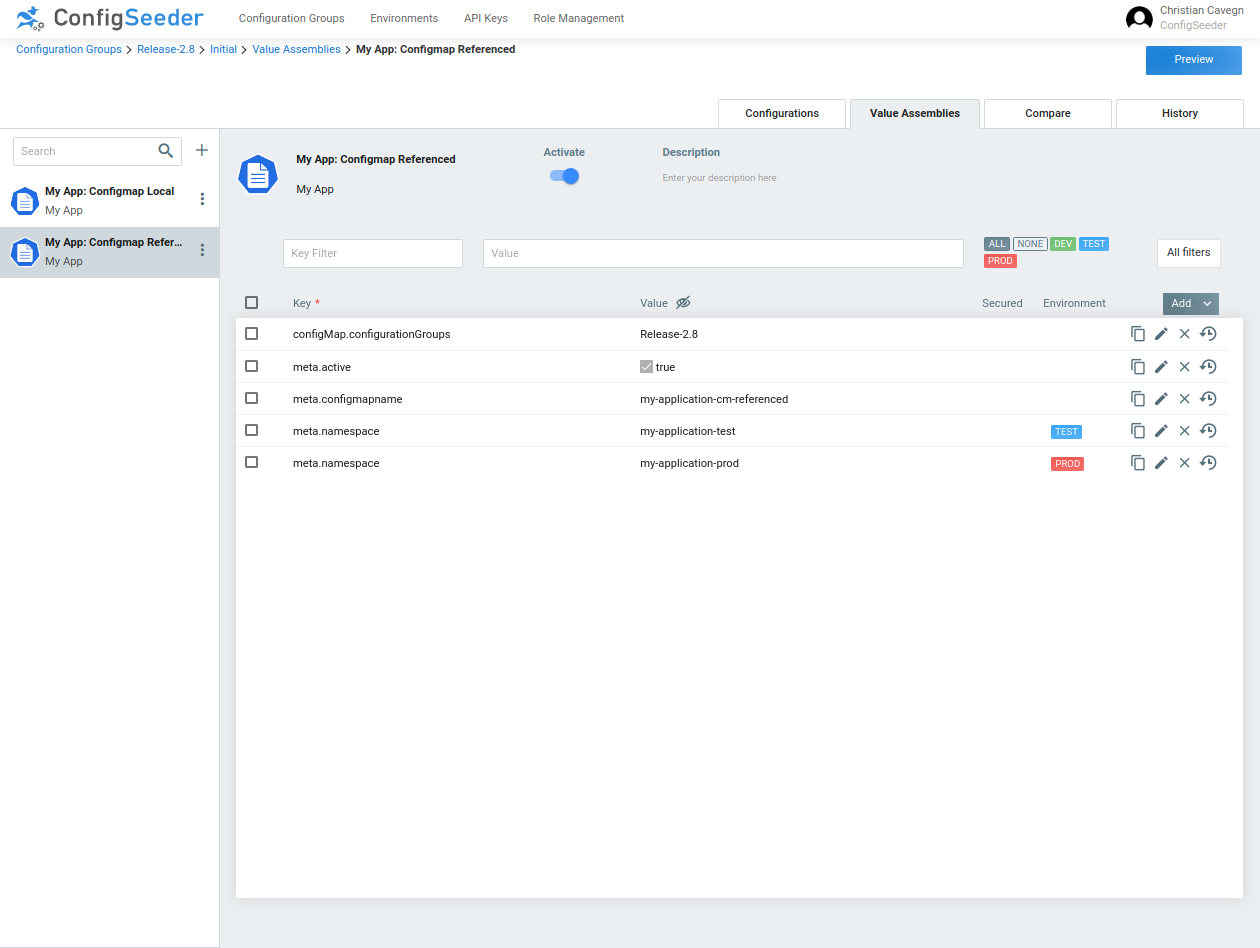
With the configuration group containing the following values:

The example above would create a ConfigMap named my-application-cm-referenced
-
in the namespace
my-application-testcontaining the keya_keywith valuea_value_test -
in the namespace
my-application-prodcontaining the keya_keywith valuea_value_prod
|
When managing a ConfigMap with ConfigSeeder
|
The created kubernetes object should look like this:
kubectl get cm -n my-application-test my-application-cm-referenced -o yaml
apiVersion: v1
data:
a_key: a_value_test
kind: ConfigMap
metadata:
annotations:
configseeder.com/dataHash: f9724b05cdbf38c3ba95325edfe26f166b3d73046e9804af6d672e74d9c9a1f4
configseeder.com/managed: "true"
configseeder.com/module: CMM_KVR
name: my-application-cm-referenced
namespace: my-application-test4.4.2. Usage of Configuration Values within Value Assembly
| Key | Mandatory | Value |
|---|---|---|
|
yes |
Reference to one ore more configuration groups. The ConfigMap created by this module will contain all key / value pairs. |
|
no |
If configured, only keys matching the pattern will be included in the ConfigMap. To include all keys:
To include all keys with prefix / infix / postfix:
To include exactly two specified keys:
|
|
yes |
Name of the ConfigMap which will be created because of this Value Assembly. If more than one Environment is used, there could be
However, we recommend having a dedicated namespace for each application and environment. |
4.5. Secret: Key/Value Local (Module SMM)
4.5.1. Introduction
This module is responsible for creating and managing Secrets containing key / value pairs.
The key / value pairs are configured directly in a Value Assemblies of type Secret: Key/Value (Local) within ConfigSeeder:
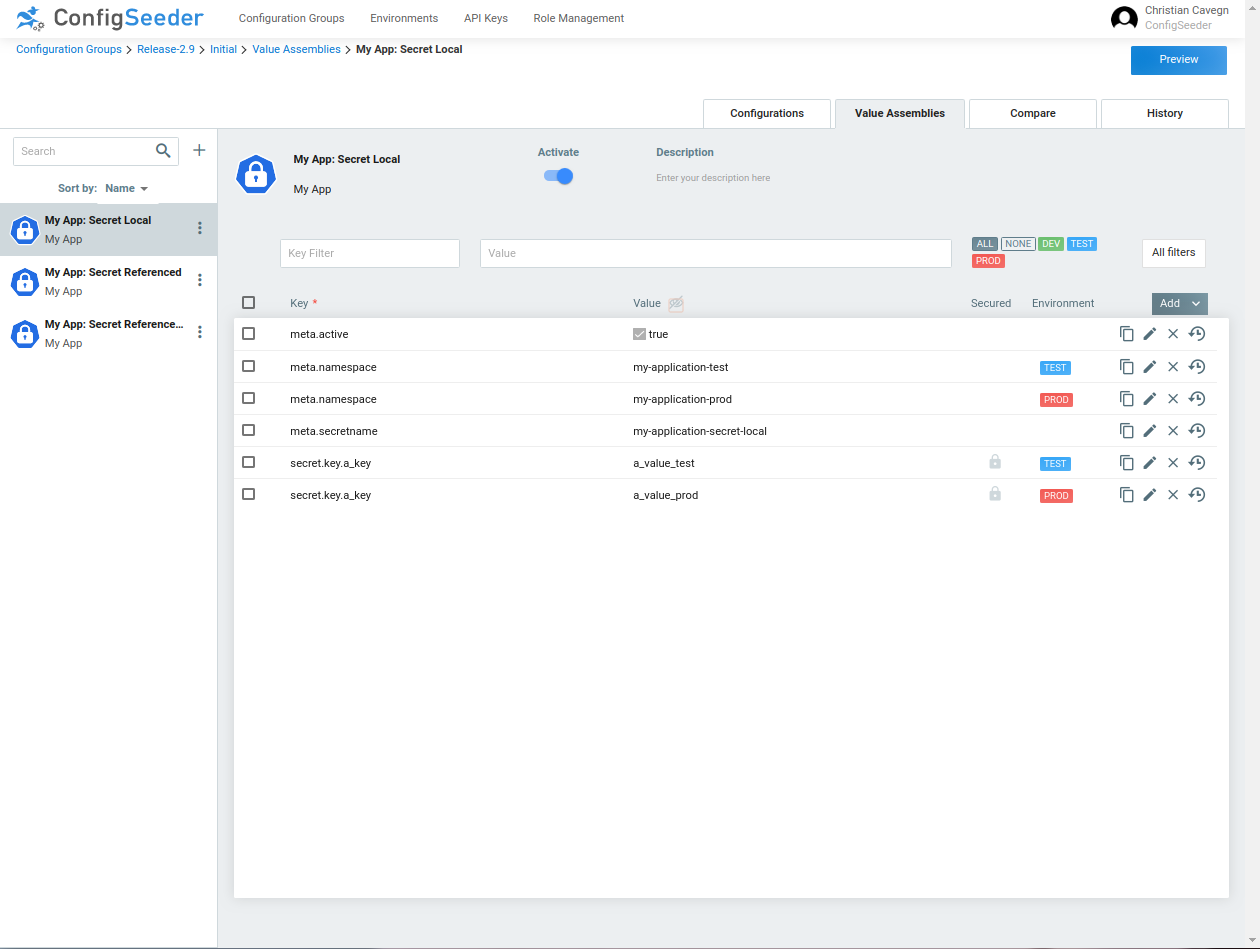
The example above would create a Secret named my-application-secret-local
-
in the namespace
my-application-testcontaining the keya_keywith valuea_value_test -
in the namespace
my-application-prodcontaining the keya_keywith valuea_value_prod
|
When managing a Secret with ConfigSeeder
|
The created kubernetes object should look like this:
kubectl get secret -n my-application-test my-application-secret-local -o yaml
apiVersion: v1
data:
a_key: YV92YWx1ZV90ZXN0
kind: Secret
metadata:
annotations:
configseeder.com/dataHash: f9724b05cdbf38c3ba95325edfe26f166b3d73046e9804af6d672e74d9c9a1f4
configseeder.com/managed: "true"
configseeder.com/module: SMM_KVL
name: my-application-secret-local
namespace: my-application-test
type: Opaque4.5.2. Usage of Configuration Values within Value Assembly
| Key | Mandatory | Value |
|---|---|---|
|
yes |
Key-Value Entry which will be contained in the Secret. |
|
yes |
Name of the Secret which will be created because of this Value Assembly. If more than one Environment is used, there could be
However, we recommend having a dedicated namespace for each application and environment. |
4.6. Secret: Key/Value Referenced (Module SMM)
4.6.1. Introduction
This module is responsible for creating and managing Secrets containing key / value pairs.
The Secrets is defined with an Value Assemblies of type Secrets: Key/Value (Referenced).
The key / value pairs are configured in one ore more referenced confguration group.
Configuration of a Secrets: Key/Value (Referenced) Assembly in ConfigSeeder:
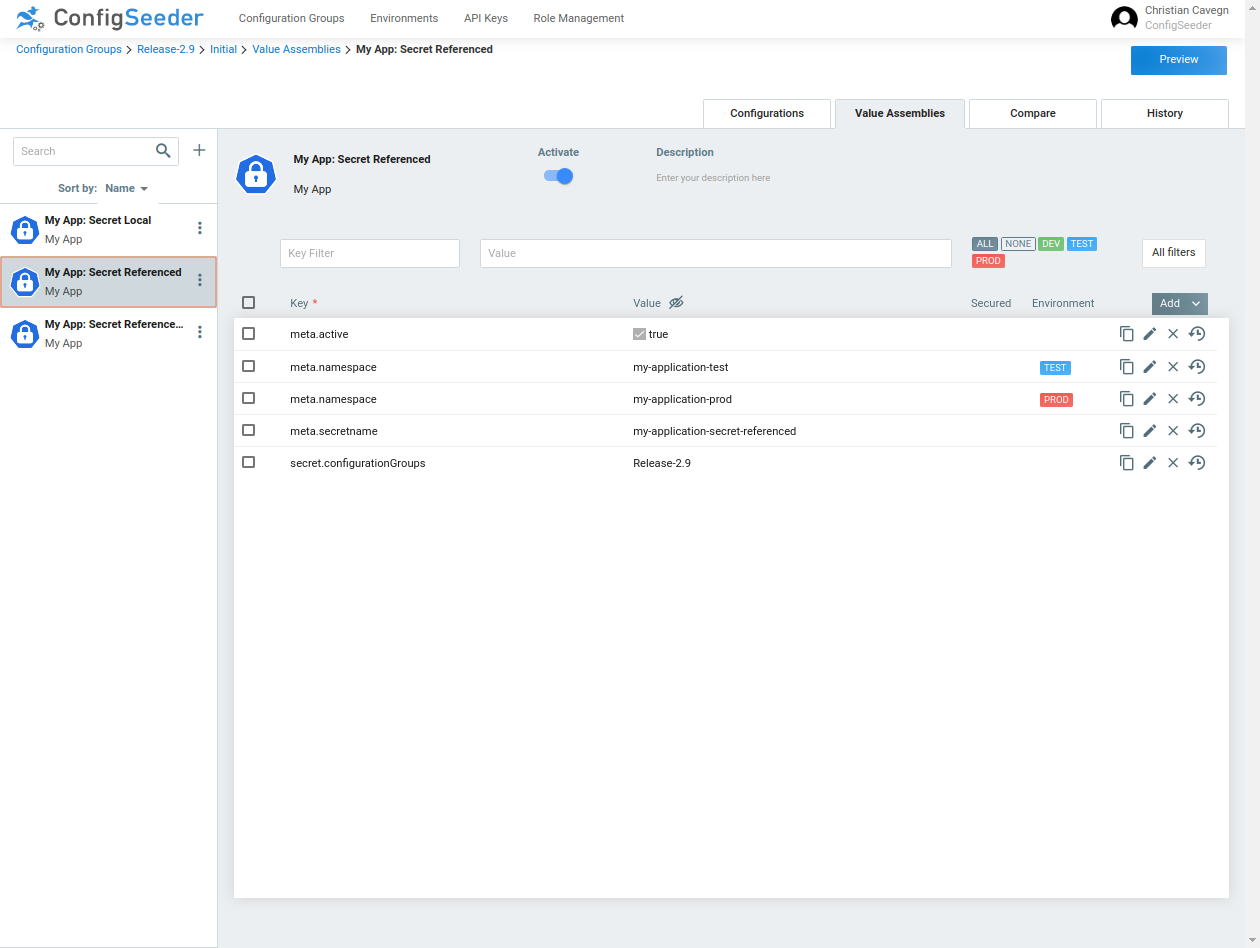
With the configuration group containing the following values:

The example above would create a Secret named my-application-secret-referenced
-
in the namespace
my-application-testcontaining the keya_keywith valuea_value_test -
in the namespace
my-application-prodcontaining the keya_keywith valuea_value_prod
|
When managing a Secret with ConfigSeeder
|
The created kubernetes object should look like this:
kubectl get secret -n my-application-test my-application-secret-referenced -o yaml
apiVersion: v1
data:
a_protected_key: YV9wcm90ZWN0ZWRfdmFsdWVfdGVzdA==
kind: Secret
metadata:
annotations:
configseeder.com/dataHash: 003d8ccb77400afb767eb3088b63d216300a29eda76295873ad00a48f29e5e46
configseeder.com/managed: "true"
configseeder.com/module: SMM_KVR
name: my-application-secret-referenced
namespace: my-application-test
type: OpaqueIt is also possible to include unprotected key/value pairs in the generated secret.
This can be achived by setting the secret.includeUnprotected-flag:
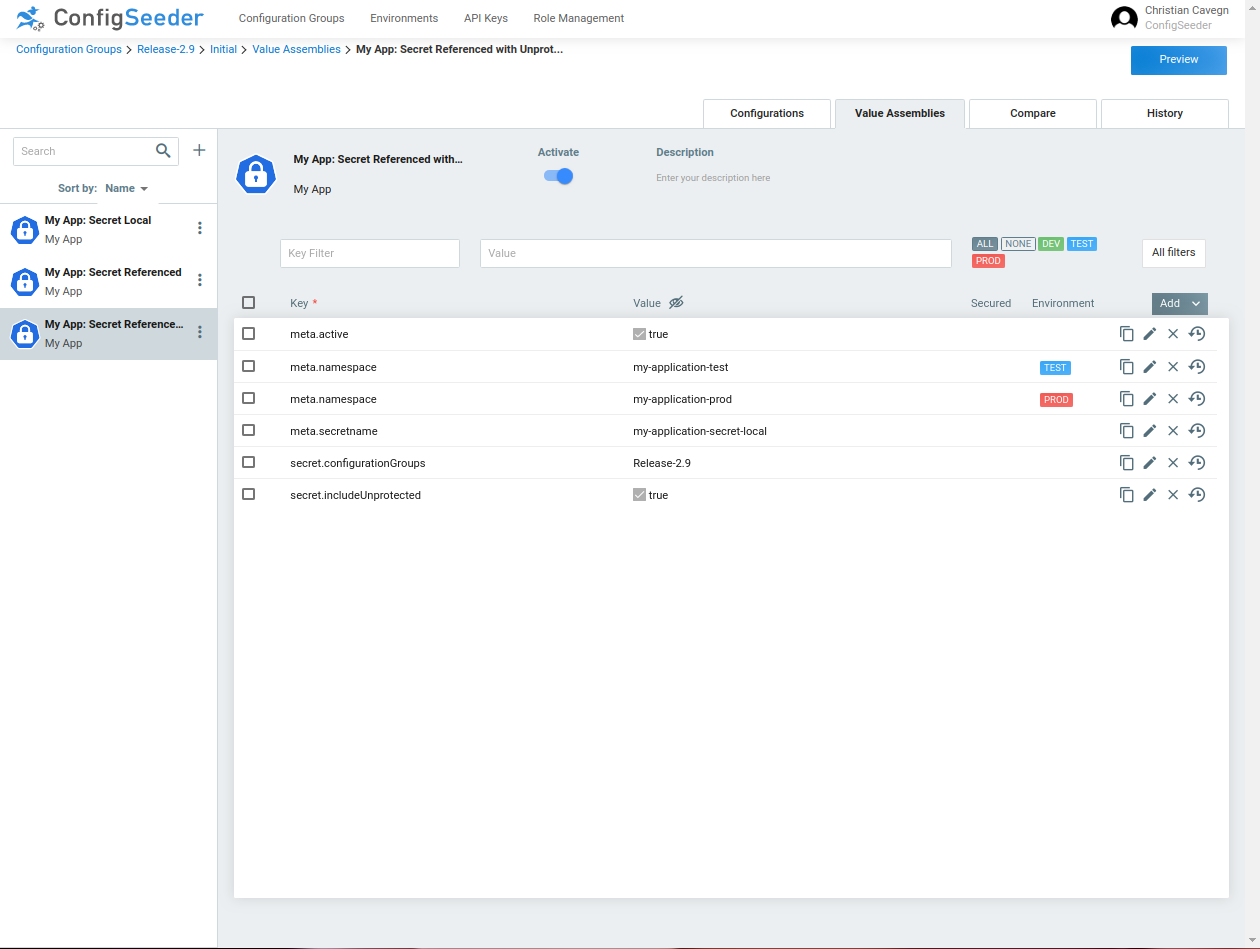
The created kubernetes object should look like this:
apiVersion: v1
data:
a_key: YV92YWx1ZV90ZXN0
a_protected_key: YV9wcm90ZWN0ZWRfdmFsdWVfdGVzdA==
kind: Secret
metadata:
annotations:
configseeder.com/dataHash: b483a69f8a9e40c8a2ec7e841953e15107ff5e956516a069e4272db54b050142
configseeder.com/managed: "true"
configseeder.com/module: SMM_KVR
name: my-application-secret-referenced-with-unprotected
namespace: my-application-test
type: Opaque4.6.2. Usage of Configuration Values within Value Assembly
| Key | Mandatory | Value |
|---|---|---|
|
yes |
Reference to one ore more configuration groups. The Secret created by this module will contain all key / value pairs. |
|
no |
If configured, only keys matching the pattern will be included in the Secret. To include all keys:
To include all keys with prefix / infix / postfix:
To include exactly two specified keys:
|
|
no |
Set to true, if unprotected values should be included in the secret. |
|
yes |
Name of the Secret which will be created because of this Value Assembly. If more than one Environment is used, there could be
However, we recommend having a dedicated namespace for each application and environment. |
5. Status and Metadata
5.1. Status (stored per Kubernetes Connector)
The Kubernetes Connector stores its state in a ConfigMap, normally the name is configseeder/kubernetes-connector-state.
The state contains an overview of all objects managed by the connector, the last action and information if the last action was executed successfully or details to the failure if the action has failed.
|
Do not modify state-information unless you know what you are doing! There should be no reason to modify the state-information and there is a big chance of destroying the state if tempered with it. If the Kubernetes Connector is unable to read the state or is otherwise unable to interpret it, the state can be deleted. This leads to a new beginning / recreating of configuration data in the Kubernetes Cluster. |
5.2. Metadata (stored per managed object)
The Kubernetes Connector stores Metadata in every managed object. The following annotations are used:
configseeder.com/managed
Boolean flag which defines if an object is managed by Kubernetes Connector, meaning if Kubernetes Connector is allowed to modify or delete the given object. If a ConfigSeeder managed object shouldn’t be modified or deleted by the Kubernetes Connector, this flag can be deleted or set to false.
configseeder.com/module
String value which defines which module of the Kubernetes-Connector is responsible for managing the file.
Manually Read or Modify Metadata
Reading Metadata:
kubectl get secrets -n <namespace> <secret> -o yaml
kind: Secret
metadata:
annotations:
configseeder.com/managed: "true"
configseeder.com/module: AKM
...
Writing Metadata:
Do not modify metadata unless you know what you are doing! There should be no reason to modify the
metadata other than perhaps set annotation configseeder.com/managed to false if a file should be removed from
ConfigSeeder control
|
kubectl edit secrets -n <namespace> <secret>